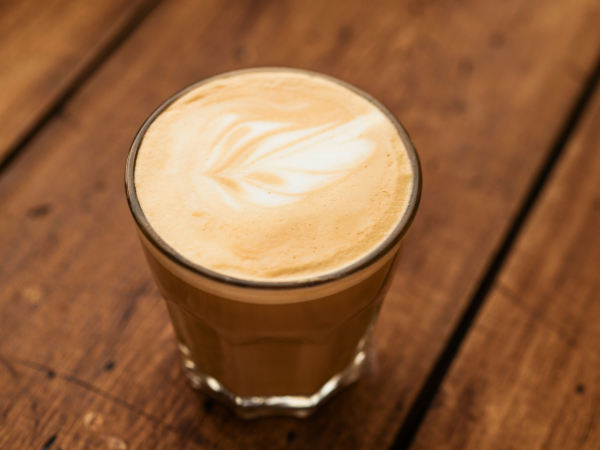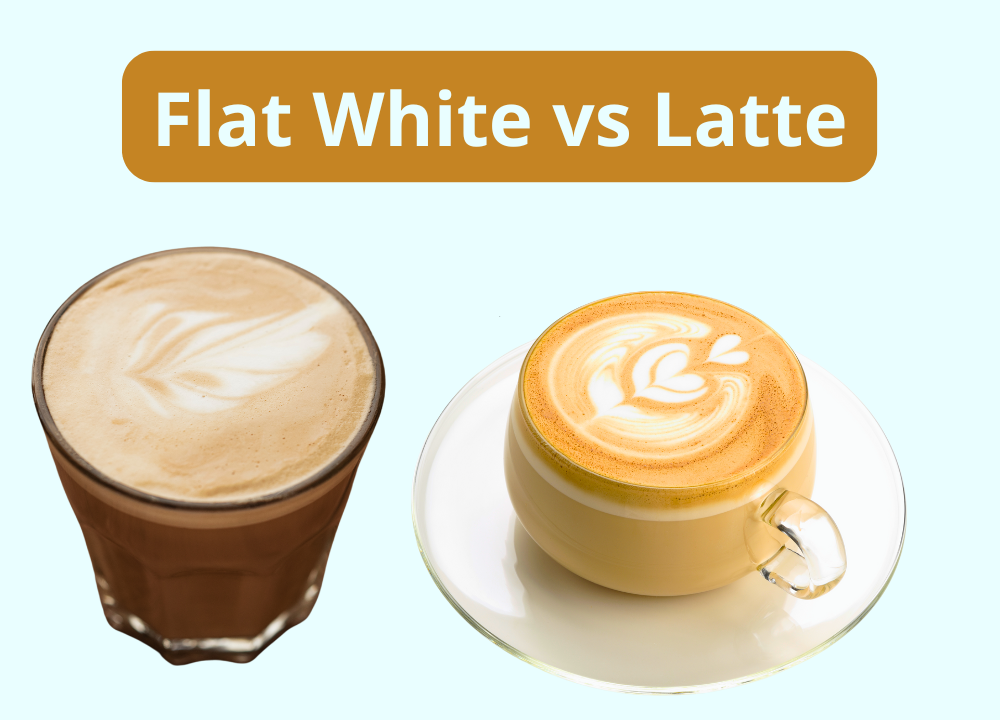Choosing between a flat white and a latte depends on your taste preference. Flat whites offer a robust coffee experience with a higher coffee-to-milk ratio. They typically contain less foam and are served in smaller cups. Lattes, on the other hand, are creamier with more steamed milk and a light layer of foam on top.
What Is A Flat White?
A Flat White is a special coffee drink that originated in Australia and New Zealand. It has become popular worldwide, especially among those who appreciate a stronger coffee flavor with a creamy texture.
Ingredients Of A Flat White
A Flat White consists of the following ingredients:
- Espresso: The base is a shot of rich, full-bodied espresso.
- Steamed Milk: Microfoam, which is steamed milk with tiny, fine bubbles, adds a velvety texture.
Preparation Method
The preparation of a Flat White involves:
- Pulling a shot of espresso.
- Steaming the milk to create microfoam.
- Poring the microfoam over the espresso, creating a silky-smooth blend.
What Is A Latte?
A Latte is a beloved coffee drink enjoyed worldwide. It combines espresso and steamed milk to create a smooth, creamy beverage. Baristas often add a small layer of foam on top.
Latte Ingredients
- Espresso: The base of every Latte, providing a rich coffee flavor.
- Steamed Milk: Adds creaminess and sweetness to the drink.
- Foam: A thin layer of milk foam crowns the Latte, adding a light texture.
Latte Preparation
- Pull a shot of espresso.
- Steam the milk until it is hot and frothy.
- Pour the steamed milk over the espresso.
- Top with a small layer of foam.

Key Differences Between Flat White And Latte
Understanding these differences can help you pick your perfect coffee. Let’s dive into the key differences between Flat White and Latte.
Milk To Coffee Ratio
Flat White has a higher coffee to milk ratio. This gives it a stronger coffee flavor.
Latte has more milk than coffee. It tastes creamier and milder.
Texture And Foam
A Flat White has a velvety texture with microfoam. The microfoam is silky and smooth.
A Latte has more foam. The foam is light and airy, making it fluffier.
Serving Size
| Drink | Serving Size |
|---|---|
| Flat White | Smaller, around 6 oz |
| Latte | Larger, around 8-12 oz |
Milk Texture And Microfoam: Flat White Vs Latte
In this section, we dive into the details of milk texture and microfoam, helping you determine which coffee suits your taste.
Milk Texture In Flat White
A flat white features a velvety, smooth milk texture. Baristas achieve this by steaming the milk to create a fine, glossy microfoam. The milk blends seamlessly with the espresso, resulting in a creamy consistency that enhances the coffee’s flavor.
Milk Texture In Latte
Lattes have a lighter, airier milk texture. The milk is steamed to incorporate more air, creating a frothier texture. This frothy milk sits atop the espresso, providing a contrast between the rich coffee and the lighter milk foam.
Microfoam In Flat White
The microfoam in a flat white is dense and rich. Baristas craft it by steaming the milk until it reaches a creamy consistency with tiny bubbles. This microfoam integrates with the espresso, producing a silky mouthfeel.
Microfoam In Latte
Lattes feature a lighter microfoam with larger bubbles compared to flat whites. This foam creates a distinct layer on top of the espresso, adding a light and airy texture to the drink.

How Much Caffeine Is In A Latte Vs Flat White?
Both the Latte and Flat White contain espresso, which is the main source of caffeine. The difference in caffeine content largely depends on the number of espresso shots used in each drink.
Latte
- Standard Size: A typical latte is made with one or two shots of espresso.
- Caffeine Content: Each shot of espresso contains approximately 63 mg of caffeine.
| Latte Size | Number of Espresso Shots | Caffeine Content (mg) |
|---|---|---|
| Small | 1 | 63 |
| Medium | 2 | 126 |
| Large | 3 | 189 |
Flat White
- Standard Size: A flat white typically contains two shots of espresso.
- Caffeine Content: With two shots, the caffeine content is around 126 mg.
| Flat White Size | Number of Espresso Shots | Caffeine Content (mg) |
|---|---|---|
| Standard | 2 | 126 |
In summary, a flat white usually has more caffeine than a small latte but is on par with a medium latte. This information can help you decide which coffee suits your caffeine needs best.
Taste Comparison: Flat White Vs Latte
Understanding the taste differences will help you select your perfect coffee. Let’s dive into the Taste Comparison.
Flat White Flavor Profile
The Flat White has a rich, creamy texture. It uses a double shot of espresso, giving it a strong coffee flavor. The milk is steamed to a velvety microfoam, blending smoothly with the espresso. This creates a balanced taste, with the coffee flavor shining through more than the milk.
Latte Flavor Profile
A Latte offers a milder coffee experience. It uses a single shot of espresso, which is mixed with more steamed milk than a Flat White. This results in a creamier and milkier taste. The coffee flavor is more subdued, making it a smooth and comforting drink.
Comparative Taste Table
| Characteristic | Flat White | Latte |
|---|---|---|
| Espresso Shots | Double Shot | Single Shot |
| Milk Texture | Velvety Microfoam | Steamed Milk |
| Overall Taste | Strong Coffee Flavor | Milder Coffee Flavor |
Key Differences
- Flat White has a stronger coffee taste due to the double shot of espresso.
- Latte is creamier and milkier with a single shot of espresso.
- The milk in a Flat White is a velvety microfoam, while in a Latte, it is steamed milk.
Choosing Your Coffee
If you prefer a bolder coffee taste, go for a Flat White. It highlights the espresso flavor with a creamy texture. If you enjoy a smoother, milkier drink, a Latte is perfect. It offers a more balanced, mellow coffee experience.
Calorie Count And Nutritional Differences
Both drinks are popular and delicious, but they offer different taste experiences.
Calorie Count
Flat Whites typically have fewer calories than Lattes. This is due to the smaller amount of milk used in a Flat White. A standard Flat White made with whole milk has around 120-150 calories. On the other hand, a standard Latte contains more milk, leading to a higher calorie count of around 150-190 calories.
Macronutrients
Both drinks provide essential macronutrients, but the quantities differ. Here’s a breakdown:
| Drink | Calories | Protein (g) | Fat (g) | Carbs (g) |
|---|---|---|---|---|
| Flat White | 120-150 | 7-9 | 6-8 | 10-12 |
| Latte | 150-190 | 9-12 | 8-10 | 12-15 |
Sugar Content
Sugar content is another factor to consider. Both drinks can be made with whole, skim, or plant-based milk, which affects the sugar levels. On average:
- Flat White: Contains 10-12 grams of sugar.
- Latte: Contains 12-15 grams of sugar.
Milk Options
Using different types of milk alters the nutritional profile. Here’s a brief comparison using whole milk and almond milk:
| Milk Type | Calories | Protein (g) | Fat (g) | Carbs (g) | Sugar (g) |
|---|---|---|---|---|---|
| Whole Milk | 150 | 8 | 8 | 12 | 12 |
| Almond Milk | 50 | 1 | 2.5 | 2 | 1 |
Special Dietary Needs
People with lactose intolerance or vegan diets might prefer plant-based milk options. These options often have fewer calories and less sugar. For instance, using almond milk can reduce the calorie count to around 50-70 calories per cup.

